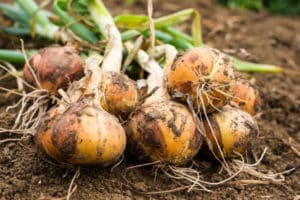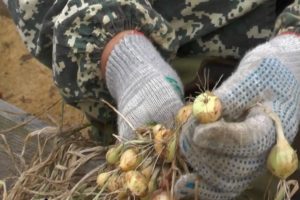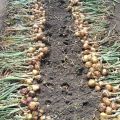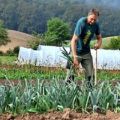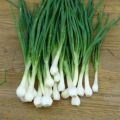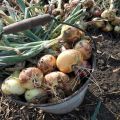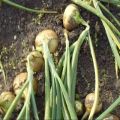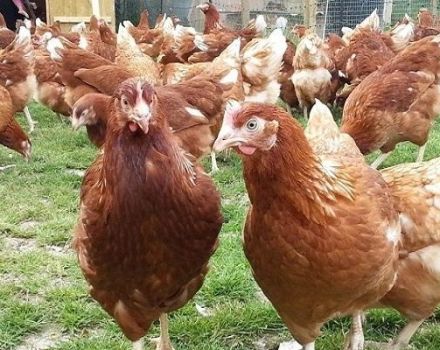When do you need to dig onions from the beds for storage?
There are many criteria by which to determine when it is best to dig onions. The quality of the bulbs and the duration of their storage depend on the correct timing of the harvest.
How to determine the ripeness of root crops?
The harvesting time of onions largely depends on the variety and the characteristics of the weather conditions. There are varieties with early, medium and late harvest ripening. Ripening time increases in colder regions.
You can determine that you need to remove the onions from the beds by external signs:
- the stems turn yellow, dry up;
- feathers from an upright position gradually fall on the beds (if the summer is cold, then the feathers turn yellow later than the bulb itself ripens);
- the neck of the bulb becomes thin and soft;
- maturity can be determined by the bulb itself, dry scales should be freely removed from it;
- the taste of the turnip is juicy, the plates are crispy, with a pleasant aroma.

On a mature bulb, the tops should lie on the ground. But the ripening of the bulbs is uneven, the feathers may not turn yellow and dry out in all plants. They start harvesting as soon as most of the plants have tops.
Some vegetable growers are guided by the dates indicated in the lunar calendar. In this case, the boundaries of the harvest fall in mid-July and last until early August. The moon should be waning.
You can calculate the date of digging the crop in a simple mathematical way. To do this, add 65–80 days to the date when the vegetable was planted. The number of days depends on the type of onion planted. The result will be the exact harvest date. In the case of rainy and cold summers, a few more days are added.
Collection features
As soon as all the external signs of onion ripeness were found (leaves turned yellow, the neck dried out, and the outer scales dried up), you can start harvesting from the site.
The onions are pulled from the garden (it is better to use a pitchfork), gently shake off the ground and leave to dry. You should not beat the bow against each other, trying to get rid of the adhering dirt. This causes damage to the heads and the beginning of rotting.
Onions are harvested in the garden, folded in two or three layers. From time to time you need to turn over with different sides to the sun. If the weather is dry, warm, you can dry it for 7-10 days. In the sun, the onion finally ripens, dries and disinfects.
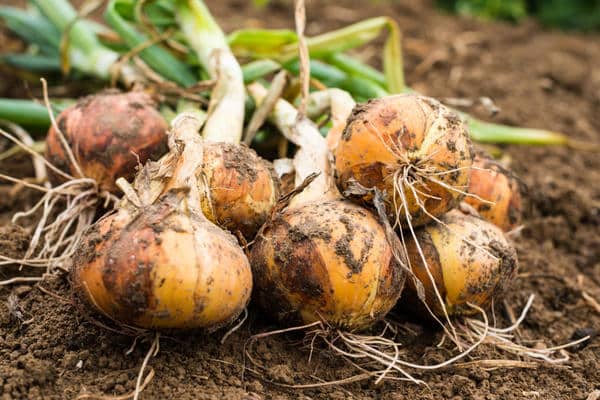
Preparatory work
Harvesting technology includes a number of recommendations to help improve the quality of the crop and reduce the number of spoiled bulbs:
- Two weeks before the expected harvest, they stop watering, loosening and fertilizing the beds (these activities contribute to the growth of tops and delay the ripening of the bulbs).The bulbs will dry out, and this factor will have a beneficial effect on storage. If it rains, it is recommended to cover the beds with a film.
- A week before the proposed procedure, it is recommended to peel the bulb by half of the soil. Slightly exposed heads will receive more light.
- It is better to start harvesting in the early morning, when the sun is just rising.
- Cleaning is done in dry, sunny weather.
- When the onions are ripe, you do not need to pull them out by hand. Better to use a shovel or pitchfork, carefully digging in the ground.
- The dug out onions are laid out on a cloth cloth, allowing them to dry out in the sun. If the weather is rainy, then the onions are harvested in a well-ventilated area.
- Onions can be harvested for several days, but do not overexpose them in the ground.
It is not recommended to cut off the leaves immediately. They contain many nutrients that will enter the bulb for a long time after digging the vegetable out of the ground.
If you start harvesting ahead of time, the bulbs will be less dense and juicy, and the shelf life will be significantly reduced. If you overexpose the bulbs in the ground, then not only the taste will suffer, but also the risk of rotting will increase. Most bulbs, when overexposed in the ground, begin to crack and rot.
Features of collection in rainy weather
When the weather is not happy, vegetable growers are concerned about the question: when to harvest onions in rainy weather? Pick the driest day for harvesting. Most often, the crop dries longer and is stored little.
Onion ripening is delayed in wet weather. In this case, you need to know the techniques to help ripening. The bulbs, together with the roots and soil, are lifted with a pitchfork (the roots are undermined) and left in this position to dry the tops. You can move the soil away from the bulbs and prune the roots. All these actions will lead to rapid yellowing and drying of the tops, as well as ripening of the bulbs.

If the weather is rainy, the bulbs should be removed under a roof or in a well-ventilated area. Turn over periodically. After the onion dries, it is peeled from the upper husk, the leaves are cut off, leaving about 5 cm of stumps.
How to accelerate ripening?
If the onion harvest time has come and the rainy season is approaching, and the feathers are still green and there is no hint of wilting, some measures can be applied.
- The lack of moisture will help speed up the ripening process. The beds are no longer watered and the plant is not fed for development.
- You can undermine the roots by slightly lifting with a pitchfork. If the ground is loose and dry, then you can manually pull the tops a little.
- You can expose the bulbs by pushing back the topsoil. But this method can only help if the head is set too deep.
If you planted a vegetable a little later than the due date, the tops will also help the bulbs to ripen. To do this, it does not need to be cut for another 7-10 days after harvesting the vegetable from the garden.
How to collect the testes?
It is best to collect seeds for planting a vegetable next year from your garden. After harvesting, the bulbs are selected for seeds, which are distinguished by a high density, with a diameter of about 10 cm. The selected bulbs must be stored warm for three months. During this time, they will be covered with a large number of scales.
Planting of bulbs for seeds begins earlier, in the last days of April, as it takes more time for seed formation. Before placing in the holes, the neck is cut off to juicy scales so that the seedlings appear faster. There should be a distance of about 25 cm between the rows, the distance between the bulbs in a row should be at least 15 cm.
At the end of summer (the last days of August) seeds ripen - nigella. Onion leaves begin to turn yellow and dry.

It is imperative to properly collect the seeds and ensure proper storage:
- They start collecting seeds when the capsules begin to burst.
- The arrows are cut, collected in bunches and suspended under a canopy until final ripening.
- It is imperative to lay paper under the hanging arrows, where the ripe seeds will be poured.
- Rub the inflorescences on their own to get the remaining seeds.
- After that, it was recommended to select high-quality planting material. Seeds are placed in a glass of water. Those that surfaced are thrown away.
- The remaining good seeds are spread on the fabric surface and left to dry.
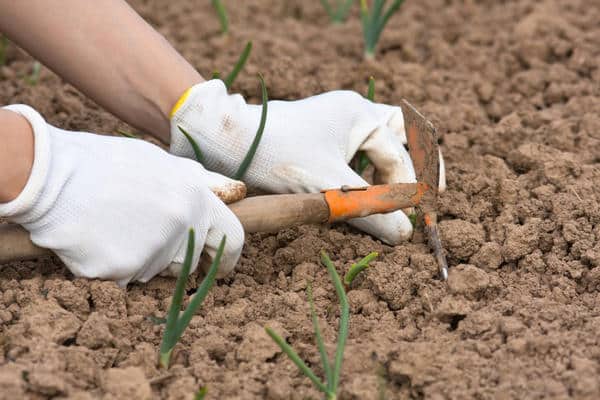
The collected seeds are stored in a tissue bag in a dry, dark place. After sowing nigella seeds, onion sets grow. It ripens in about 85–90 days. The collection can last from late July to early September. But do not leave until frost and heavy rains.
In order for all the useful properties to be preserved in the seed, you need to harvest on time. The fact that the sevok is ripe can be recognized by external signs: the leaves turn yellow, dry and lethargic, the neck is soft and dry. There is no need to wait for the leaves to fall on the beds. Such a crop is poorly stored, and after planting next year only arrows will form.
They begin to dig out the harvest in dry weather. You can pull it out by hand, there is also a way when the onion is pulled out with a pitchfork.
Drying the bulbs before storage
On average, complete drying of the harvested crop takes two weeks. During the drying process, all pathogenic bacteria are destroyed. It is best to dry in the sun, right in the beds. The wind and the sun's rays are good for this process. At night, you can clean it under a canopy so that the dew does not get wet again.
If the bulbs are left to dry in the garden even at night, then in the morning it is recommended to cover them with a film so that the dew cannot harm the crop.
When the onion dries out a little, they begin to trim the tops. Leave a stump 5 cm long. If you plan to weave braids, you can dry it along with the feathers. Their length must be at least 15 cm.

Storage secrets from a seasoned summer resident
It is imperative to observe the storage conditions for onions. Only whole, dense onion heads are suitable for storage. They can be arranged in wicker baskets, wooden or plastic crates with holes or nets. You can simply put several heads together and tie them with a rope into a bundle, hanging from the ceiling.
You can weave braids from the tops. In this case, after drying, the leaves do not need to be cut, they are simply woven together. All bulbs are well ventilated and rarely rot.
It is important to know at what temperature the onions should be stored throughout the winter. It is best to store in a dark, cool place (for example, in a basement or cellar), where the air temperature is from 0 to +5. Air humidity not more than 80%. If the air humidity is higher, the risk of crop rotting and germination increases. There must be good ventilation in the room. If the onions are kept at home, then they should be kept away from heating appliances, with good air flow.
Some experienced gardeners know their secrets on how to properly store the harvested crop. To prevent the decay process, sprinkle the heads with chalk. Only such a bow can no longer be planted in the ground.
